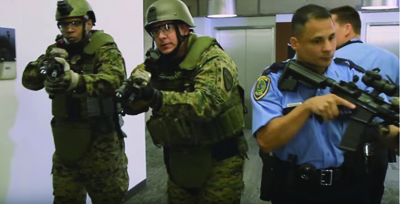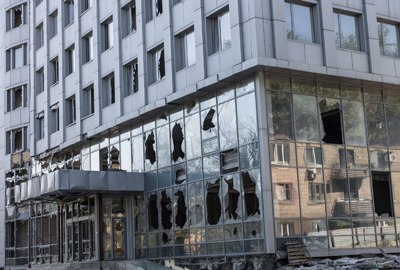
BULLETS and bombs, coups and crimes, typhoons and tornadoes, earthquakes and epidemics – these are the stuff of organisers’ nightmares when it comes to planning events.
And there is no longer a guarantee that anywhere is safe, according to Geoff Donaghy, president of the International Association of Congress Centres (AIPC) and CEO of International Convention Centre Sydney (ICC Sydney), who made the point in an editorial in ‘Communique’, the AIPC house magazine.
 Lane Aldred (right), regional security manager Asia Pacific with International SOS and Control Risks, has a different take on the issue. “Safe is not a term we use,” he says. “Safe is a very subjective term. That’s why we deal with degrees of risk. Depending on the level of risk we can advise mitigating strategies.”
Lane Aldred (right), regional security manager Asia Pacific with International SOS and Control Risks, has a different take on the issue. “Safe is not a term we use,” he says. “Safe is a very subjective term. That’s why we deal with degrees of risk. Depending on the level of risk we can advise mitigating strategies.”
Aldred is a veteran security and risk management consultant, specialising in providing security consultancy, advice and training, to companies and government agencies.
He says the key to addressing risk is preparation, both on the part of organisers and travelling delegates.
“From an organisational point of view there are a number of things that can be done at the front end of the risk curve in terms of identifying what kind of risks there are in the first place,” he says.
“Sending travellers with no information or bad or incorrect information into any country has the potential to be fraught with all sorts of danger.
“It is about getting organisations to understand that there is a moral obligation. And we are increasingly seeing a legal obligation – in the form of a duty of care – to make sure they are doing the right things for their people. They are sending people to different countries to work for them, to sustain and grow the business, and that can only occur if there is mission success.
“If there is mission failure, it is going to cost; possibly the travellers, the travellers’ families, and it will certainly cost the company, not just financially, but in terms of people. Reputation will be a big issue too.
Street crime
“Understanding the risk context in whatever the destination is really the key thing, and so the company has a lot of heavy lifting to do in that respect; having mechanisms to identify risk, quantify it, and then help the traveller understand how they can mitigate it, depending on what that risk level is.
“On the individuals’ side, it really is about understanding what those risks are… Understanding, for example, how they deal with street crime, how they stay safe in a hotel, how they select modes of transport, how they are able to be tracked while travelling, and how they can get information on breaking events in real time in order to react to them,” Aldred says.

 Soft targets
Soft targets
Writing in the PCMA magazine Convene, Stuart Ruff-Lyon (left), vice-president, events and education for the Risk Management Society, says that while event security is an obsession – usually constrained by budgets – he is surprised by the often-scant security at some conferences.
“People who think the risk isn’t there perhaps have their heads in the sand,” he says. “To me, the soft targets and vulnerability [of conferences] are bound to be exploited if we don’t do what we can to step up our game and increase our security budgets.” He adds that one high-profile incident could have a major impact.
A members’ survey on security carried out by UFI, a global association for the exhibition industry, in June last year showed that up to 28 per cent reported taking additional action to minimise risk “in the context of the past terrorists attacks in several places across the world”.
Behaviour
Respondents were asked “have you expanded security measures around your exhibitions/your venues in recent months? If so, please identify these actions”.
UFI interpreted the results as meaning that “security is also high on the agenda with a large majority of companies declaring having implemented additional measures in the recent months”, even though 42 per cent of respondents said they had not taken any additional measures.
 Sonia Thomas (right), director of operations at UFI, based in Paris, told MIX that event security is “sometimes the elephant in the room”, but that it is “a subject that needs to be addressed”.
Sonia Thomas (right), director of operations at UFI, based in Paris, told MIX that event security is “sometimes the elephant in the room”, but that it is “a subject that needs to be addressed”.
“It is important to raise awareness among clients without alarming them unnecessarily. Some venues are using changes in behaviour to identify risks from individuals which may or may not prove useful,” she says.
“Event planners have an obligation to raise awareness among their staff and train them accordingly.
“It is very important to do a complete risk assessment to establish possible risks and minimise them. This should be done by the venue in association with local competent authorities and even with external experts if the know-how is not available in-house.”
 Rod Cameron (left), executive director of the Joint Meetings Industry Council, says that in addition to identifying risk and having “an appropriate and up-to-date emergency response plan that addresses all the major components of any potential emergency”, it is important to have people in place who can deal with security issues.
Rod Cameron (left), executive director of the Joint Meetings Industry Council, says that in addition to identifying risk and having “an appropriate and up-to-date emergency response plan that addresses all the major components of any potential emergency”, it is important to have people in place who can deal with security issues.
“In terms of skills and mindset, part of the task of creating a good plan is to identify people within the organisations who have the kinds of qualities, like analytical abilities, calm and rational reactions and a co-operative orientation that will be required in an emergency,” says Cameron.
“This generally means a team that represents a range of such qualities rather than one or two individuals with specific positions.”
Hong Kong branch manager of Sweden-headquartered Securitas, Lai Wah-tak, says that, in addition to identifying security risks with the help of specialists, planners should work with local operators who “are the experts in that particular venue”.
 Bob Mellinger (right), CEO of the US-based enterprise management consultant Attainium, emphasises this need for planners and venue operators to work together to mitigate security risks.
Bob Mellinger (right), CEO of the US-based enterprise management consultant Attainium, emphasises this need for planners and venue operators to work together to mitigate security risks.
“Typically, venue operators, depending on the size of the venue, will take the lead with regards to security. It should be their responsibility to ensure the safety of those within their facility and to provide the planners with what is expected of them during an incident,” says Mellinger.
Counter-terrorism
Communication is vital.
“There is a delicate balance between providing adequate information for preparedness and providing so much information that attendees are overly concerned about what might occur. Keep to the basics with attendees. They just want to know that someone has the responsibility for their safety.”
 John Galea (left) has recently been appointed security manager of Melbourne Convention and Exhibition Centre (MCEC), and he says “emergency response processes and procedures, which are current, reviewed, benchmarked and tested are a must”.
John Galea (left) has recently been appointed security manager of Melbourne Convention and Exhibition Centre (MCEC), and he says “emergency response processes and procedures, which are current, reviewed, benchmarked and tested are a must”.
“[These include] an effective and tailored critical incident response plan, which includes an overview of operational responsibilities, effective communication with all stakeholders, media response and employee/patron/public welfare options.
“Benchmarking and networking are also key to continuous improvement in a changing environment. MCEC is involved on a number of key committees, including Victoria Police counter-terrorism… and other national business advisory groups around security of places of mass gathering.
“Remaining flexible, nimble and adaptable with a proactive security awareness culture and a risk-based approached is imperative.”
Gun attacks: always have an exit plan
Chilling images captured by smartphone or security cameras of a gun-wielding assailant casually, yet ruthlessly, causing as much death and destruction as they can have become an irksome sight on TV and social media.
The Professional Convention Management Association held a special session on what is known as “an active shooter situation” at its PCMA Convening Leaders event in January.
PCMA leaders convene in Austin
Delegates were referred to a video titled “Run.Hide.Fight – surviving an active shooter event”, made by Ready Houston, one of the local initiatives funded by the US Department of Homeland Security aimed at preparing people for emergencies.
“There are three things you could do that could make a difference,” the video says. “Those things are run, hide, and fight.”
- First and foremost, if you can get out, do. Always try to escape or evacuate, even when others insist on staying. Encourage others to leave with you, but don’t let them slow you down with indecision.
- If you can’t get out safely, you need to find a place to hide. Act quickly and quietly. Try to secure your hiding place the best you can. Turn out lights and, if possible, lock doors. Silence mobile phones.
- As a last resort, if your life is at risk, whether you are alone or working together as a group, fight. Improvise weaponsÖ commit to taking the shooter down.
“Try to be aware of your environment”, the video advice continues, “Always have an exit plan.”


